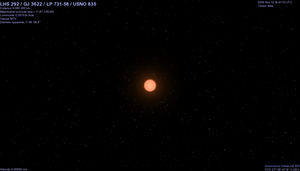
Back LHS 292 AST LHS 292 Breton LHS 292 Catalan LHS 292 German LHS 292 Spanish LHS 292 Basque الاچاس ۲۹۲ Persian LHS 292 Finnish LHS 292 French LHS 292 HE
| Observation data Epoch J2000 Equinox J2000 | |
|---|---|
| Constellation | Sextans |
| Right ascension | 10h 48m 12.61425s[1] |
| Declination | −11° 20′ 09.6107″[1] |
| Apparent magnitude (V) | 15.73[2] |
| Characteristics | |
| Spectral type | M6.5 V[3] |
| Apparent magnitude (J) | 8.9[3] |
| B−V color index | 2.10[citation needed] |
| Variable type | Flare star |
| Astrometry | |
| Radial velocity (Rv) | 1.47±0.67[1] km/s |
| Proper motion (μ) | RA: 579.019(66) mas/yr[1] Dec.: −1530.076(58) mas/yr[1] |
| Parallax (π) | 219.3302 ± 0.0602 mas[1] |
| Distance | 14.871 ± 0.004 ly (4.559 ± 0.001 pc) |
| Absolute magnitude (MV) | 17.45[2] |
| Details | |
| Mass | 0.08[2] M☉ |
| Radius | 0.11[4] R☉ |
| Luminosity | 0.00069[5] L☉ |
| Temperature | 2650-2900[5] K |
| Metallicity [Fe/H] | -0.41[citation needed] dex |
| Other designations | |
LP 731-58, GJ 3622, GCTP 2516.02 | |
| Database references | |
| SIMBAD | data |
Location of LHS 292 in the constellation Sextans | |
LHS 292 is a red dwarf star in the constellation Sextans. It is far too faint to be seen with the unaided eye and requires a large amateur telescope to be seen visually. It lies relatively close to the Solar System at a distance of about 14.9 light-years. It is a flare star, which means it can suddenly increase in brightness for short periods of time.
It has the space velocity components [U, V, W] = [28, −16, −14] km/s.[6]
- ^ a b c d e Cite error: The named reference
GaiaDR3was invoked but never defined (see the help page). - ^ a b c Cite error: The named reference
RECONSwas invoked but never defined (see the help page). - ^ a b Cite error: The named reference
SIMBAD-LHS292was invoked but never defined (see the help page). - ^ Cite error: The named reference
Morin2010was invoked but never defined (see the help page). - ^ a b Cite error: The named reference
Golimowski et al.was invoked but never defined (see the help page). - ^ Cite error: The named reference
apj705_2_1416was invoked but never defined (see the help page).

